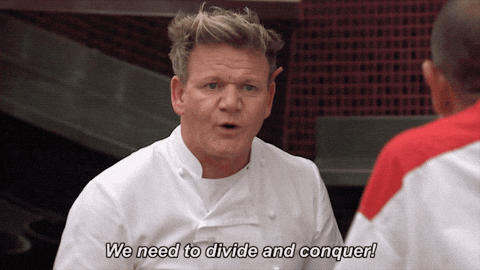- Partner Science, a Reel Axis Experiment
- Posts
- 2025 Partner Prep Step 2: The Great Divide
2025 Partner Prep Step 2: The Great Divide
Plus: The One-Prompt Partner Strategy Wonder

Congratulations, partner purgers! If you've followed last week's advice, you've probably got a leaner, meaner partner portfolio. But don't pat yourself on the back just yet. You're not even halfway to partner nirvana.
Welcome to Step 2 of our Partner Planning Bootcamp series. Today, we're diving into the art of partner segmentation. Because treating all your partners equally is like using the same pickup line at a networking event and a family reunion - wildly inappropriate and bound to fail.
Why Segmentation Matters (And Why You're Probably Doing It Wrong)
You wouldn’t use a sledgehammer to hang a picture frame, right? (If you do, we need to talk about your home improvement skills).
Similarly, you can’t use the same strategy for every partner. Some need nurturing, others need a kick in the pants, and a select few need the red-carpet treatment.
Segmentation isn’t just a fancy word to throw around in meetings. It’s your roadmap to:
Allocate resources efficiently (stop wasting caviar on partners with fast-food potential).
Tailor your communication (no more “Dear Valued Partner” emails that make everyone feel equally unimportant).
Identify growth opportunities (spot the ugly ducklings before they turn into revenue-generating swans).
Prioritize your time (because you can’t be everywhere, and let’s face it, some partners are more “meh” than others).
The Great Divide: How to Segment Like a Pro

Now that you've purged the dead weight, it's time to divide and conquer. Here's how to categorize your surviving partners:
1. The Titans (Strategic Partners)
Who they are: Your ride-or-die allies. They align with your long-term vision and have the muscle to help you dominate in 2025.
How to spot them: Look for partners with complementary tech, market reach, and a growth trajectory that matches yours.
How to treat them: Like royalty. Offer exclusive perks, co-marketing opportunities, and maybe name a conference room after them (kidding, but not really).
2. The Up-and-Comers (Growth Partners)
Who they are: The promising rookies. They've got potential, but need some TLC to become superstars.
How to spot them: High enthusiasm, decent performance, but maybe lacking in resources or expertise.
How to treat them: Like a mentee. Provide training, resources, and regular check-ins. Think of it as an investment in your future power players.
3. The Quick Wins (Tactical Partners)
Who they are: Your short-term revenue boosters. Great for immediate gains, but not part of your long-term strategy.
How to spot them: Strong in niche areas, deliver quick results, but may not align with your 2025 vision.
How to treat them: Like a summer fling. Enjoy the benefits, but don't get too attached. Focus on short-term campaigns and immediate opportunities.
The Segmentation Playbook: Your 3-Step Guide
Analyze: Dust off that spreadsheet from last week's purge. Add columns for future potential, strategic alignment, and growth trajectory.
Categorize: Again–be ruthless. If you're struggling to place a partner, they're probably not as valuable as you think. When in doubt, put them in the tactical category.
Strategize: Develop a tailored approach for each segment and partner. One-size-fits-all is for cheap t-shirts, not partner strategies (psst! The AI Learning Lab makes this task a breeze for you).
The Halo Effect: Don't Let It Blind You

Remember that partner who closed that massive deal last year? The one you can't stop bragging about at company happy hours? Yeah, they might be coasting on past glory, but don't let one shining moment blind you to current mediocrity.
The Halo Effect is the tendency to let one positive trait influence your overall judgment. In partner terms, it's assuming a partner is still amazing just because they were amazing once. It's like thinking you're still in shape because you ran a marathon... five years ago.
And no, I didn't just make this up after one too many espressos. The Halo Effect is a real cognitive bias, first identified by psychologist Edward Thorndike in 1920. It's been messing with decision-making in business, education, and pretty much everywhere else for over a century (if you want to impress at your next meeting, drop that little factoid. You're welcome).
To avoid this trap:
Use data, not emotions. That warm, fuzzy feeling? It doesn't pay the bills.
Focus on future potential, not past performance. 2025 doesn't care about that deal from 2023.
Evaluate across multiple metrics. One-hit wonders belong in the music industry, not your partner portfolio.
AI Learning Lab: The One-Prompt Partner Strategy Wonder
This AI prompt is so efficient, it'll make your coffee breaks feel like extended vacations (no, this doesn't mean you can take longer coffee breaks. Nice try).
How to Use This Prompt:
Copy the entire prompt. Yes, all of it (if copy-pasting is too challenging, maybe reconsider your career in tech).
Update the 2025 Vision with your company's actual vision and goals. Don't skip this step unless you want strategies aligned with some random AI's fever dream of the future.
Fill in the Partner Profile with actual data. Be specific – "they're good at stuff" is not a primary strength.
Feed this strategic smorgasbord to your AI of choice.
Repeat for each partner.
You are an expert partner strategist for a technology company with the following context:
Partner Segments:
1. Titans: Top-performing partners critical for major initiatives and long-term success.
2. Up-and-Comers: High-potential partners needing support to reach full capacity.
3. Quick Wins: Short-term revenue drivers, not aligned with long-term vision.
2025 Vision:
To become the industry leader in AI-driven enterprise solutions, focusing on:
1. Expanding market share in key verticals (healthcare, finance, manufacturing)
2. Driving adoption of our AI and machine learning technologies
3. Fostering innovation through strategic partnerships
4. Achieving 30% year-over-year growth in partner-driven revenue
Based on this context, create a tailored strategy for the following partner:
Partner Profile:
- Name: [Partner Name]
- Segment: [Titan/Up-and-Comer/Quick Win]
- Primary Strength:
- Biggest Challenge:
- Current Performance (1-10):
- Growth Potential (1-10):
- Unique Value Proposition:
- Key Goal for Next Year:
Provide a partner strategy that includes:
1. Strategy Summary: A 2-3 sentence overview of the tailored approach for this partner.
2. Key Initiatives: 3 specific initiatives to drive growth, address challenges, and align with our 2025 vision.
3. Resource Allocation: Recommended support (financial, technical, marketing) tailored to this partner's needs and potential.
4. Engagement Plan: Customized interaction framework (frequency, type of touchpoints) based on their segment and specific needs.
5. Success Metrics: 2 KPIs specific to this partner's growth journey and alignment with our 2025 goals.
6. Innovative Idea: One creative suggestion to differentiate our partnership and drive progress towards our 2025 vision.
Keep the tone professional yet conversational, and focus on actionable strategies that leverage the partner's strengths, address their unique challenges, and contribute to our 2025 objectives.In the next issue, we're diving into the art of partner communication during turbulent times. Because let's face it, with elections looming and the economy doing its best rollercoaster impression, your partners need more than just your quarterly "Hey, still there?" email.
I'll show you how to keep your partners feeling secure, informed, and valued - all without explicitly begging for business (because desperation is so 2023).
Until then, keep your segments tight and your communication tighter. Your 2025 self is already practicing their "I told you so" speech for when your perfectly segmented, expertly communicated partner strategy pays off big time.
Cheers,
